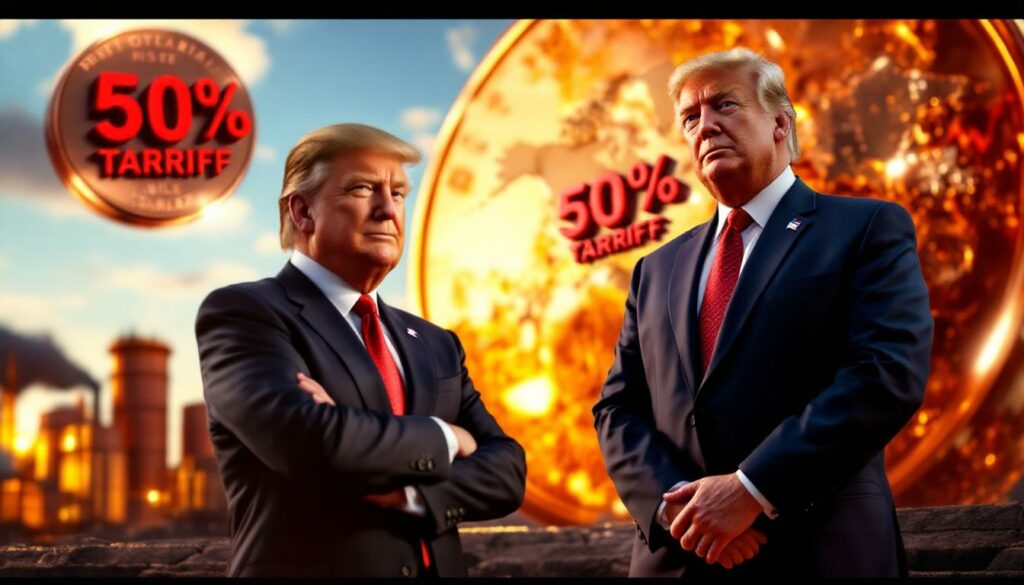What Does Trump's 50% Copper Tariff Mean for US Industry?
The announcement of a 50% tariff on imported copper scheduled to begin August 1, 2025, has sent shockwaves through metals markets and manufacturing sectors. This policy primarily targets copper cathode imports, the refined form of copper used as raw material across numerous industries. The announcement, made on July 10, 2025, has created significant uncertainty as implementation details remain unclear to major suppliers and market analysts alike.
Key information released so far indicates the tariff will primarily affect copper cathode imports rather than finished products. However, considerable ambiguity exists about whether semi-finished copper products will face the same tariffs, creating potential strategic loopholes in the supply chain.
Understanding the Scope and Timeline
The 50% tariff represents one of the most aggressive trade actions on raw materials in recent years. According to industry sources, no formal notifications have been sent to major supplying countries as of July 11, 2025, despite the announcement. This administrative gap has created significant uncertainty for suppliers and US manufacturers alike.
"Without a doubt, this will put pressure on US copper product manufacturers, which is concerning," noted Ivan Arriagada, CEO of Antofagasta, highlighting the immediate industry reaction to the tariff announcement.
Chile, which accounts for approximately 70% of US copper imports, has already begun actively seeking exemptions through diplomatic channels. Meanwhile, Canada, the second-largest copper supplier to the US market, has taken a more confrontational stance, with Canadian officials condemning the tariffs as "illegal" and threatening retaliatory measures.
US Copper Supply Dependency Analysis
The United States faces a significant copper supply gap that makes the tariff particularly impactful. Current domestic production covers only 850,000 metric tons annually, while imports account for an additional 810,000 metric tons—nearly half of total US demand. This heavy reliance on foreign copper creates immediate challenges for implementing such a substantial tariff.
With only two operational copper smelters within US borders, the domestic infrastructure for processing copper ore remains limited. Additionally, about 5% of supply needs are currently met through recycling and stockpile reduction, highlighting the multi-faceted nature of US copper sourcing.
Aurora Williams, Chilean Minister of Mines, emphasized that "Chilean producers export top-tier refined copper with a high degree of traceability," which she described as "crucial for the US manufacturing sector," underscoring the quality and importance of these imports to American industry.
How Will US Manufacturers Respond to Higher Copper Costs?
Trump's 50% tariff on copper imports represents a significant cost shock for US manufacturers that rely on copper as a primary input material. Many industry experts predict cascading effects throughout the manufacturing sector as companies struggle to absorb or pass along these substantial cost increases.
Immediate Cost Pressure Points
Manufacturers of copper wire, billets, and tubing will face the most direct impact from the tariffs. These intermediate producers serve as crucial links in the supply chain for industries ranging from construction and electrical infrastructure to automotive manufacturing and consumer electronics.
Alice Fox, a Macquarie analyst, warns that "taxing US manufacturers of intermediate products will drive up production costs and erode their international competitiveness." This competitive disadvantage could be particularly problematic for export-oriented manufacturers who must compete in global markets where rivals aren't facing similar input cost increases.
The cost pressure doesn't stop with intermediate producers. As prices increase for copper components, finished goods manufacturers will face difficult decisions about absorbing costs, redesigning products, or passing increases to consumers. Industries particularly vulnerable include:
- Electrical equipment manufacturers (wiring, transformers, motors)
- Construction materials producers (plumbing, HVAC components)
- Transportation equipment makers (automotive wiring harnesses)
- Electronics manufacturers (circuit boards, connectors)
Strategic Adaptation Options for US Buyers
US copper consumers are already developing strategies to mitigate the tariff impact. According to Macquarie estimates, many companies will initially draw down pre-accumulated inventories, a process that could provide approximately nine months of buffer before the full tariff impact is felt.
"Without broader incentives and tariffs on semi-finished products, this import dependency may persist and harm the interests of copper consumers," note industry analysts Alon Olsha and Richard Bourke, highlighting the potential limitations of the current tariff structure.
If the tariffs apply only to copper cathode but not semi-finished products, market analysts predict a significant shift in import patterns. US buyers may pivot toward importing more semi-finished copper products that fall outside the tariff scope, potentially creating a surge in these alternative imports.
Some forward-thinking manufacturers are already exploring alternative sourcing from countries potentially exempted from the tariffs, though the final exemption list remains unclear. Others are evaluating whether domestic supplier capacity could expand quickly enough to fill gaps, though most experts view this as unlikely in the short term.
Which Countries and Companies Face the Greatest Impact?
Trump's 50% tariff on copper creates winners and losers across the global metals market, with impacts varying significantly between supplying countries, domestic producers, and downstream manufacturers.
Major Supplier Reactions and Strategies
Chile stands at the epicenter of the tariff impact, providing approximately 70% of US copper imports. Chilean officials have immediately begun seeking diplomatic exemptions, highlighting their country's role as a reliable supplier of high-quality copper. Aurora Williams, Chilean Minister of Mines, emphasized that Chilean producers export "top-tier refined copper with a high degree of traceability" that remains "crucial for the US manufacturing sector."
For major Chilean producers like Antofagasta, the immediate financial impact may be manageable. Company CEO Ivan Arriagada noted that the US market represents only about 10% of their total copper price insights, with China remaining a substantially larger customer. This diversification provides some buffer against US-specific policy changes.
Canadian suppliers face a similar challenge as the second-largest source of US copper imports. However, Canada's response has been notably more confrontational. Canadian Minister of Industry Melanie Joly condemned the tariffs as "illegal" and characterized them as a "direct attack" on Canadian workers, signaling potential retaliatory measures.
Domestic US copper producers stand to benefit significantly from the protective tariff, potentially seeing higher prices for their output. However, the limited domestic production capacity means these benefits will be concentrated among a small number of companies while costs are distributed across a much broader manufacturing base.
Global Market Ripple Effects
The tariff announcement has already triggered market volatility that extends beyond US borders. While Antofagasta's CEO notes that "global supply-demand fundamentals remain strong despite tariff threats," the policy creates significant uncertainty about future trade flows.
Market analysts predict potential redirection of global copper supplies as Chilean and Canadian producers seek alternative customers. This reshuffling could create temporary regional surpluses or shortages as the market adjusts to new trade patterns.
A notable price differential is likely to emerge between US and international markets if the tariffs are fully implemented. US buyers would effectively pay a premium over world prices, creating competitive challenges for downstream manufacturers who export finished goods containing significant copper content.
Macquarie analysis suggests a prolonged market disruption period as supply chains reconfigure. This adjustment won't happen overnight—inventory strategies, contract renegotiations, and logistics changes will unfold over many months following implementation.
Can US Domestic Production Fill the Copper Supply Gap?
A central question emerging from Trump's 50% copper tariff is whether domestic US production could realistically expand to replace imports. The answer involves complex analysis of current capacity, investment timelines, and structural limitations within the US copper industry.
Current Production Capacity Assessment
The United States currently produces approximately 850,000 metric tons of copper cathode annually from domestic ore, covering roughly half of total demand. This production comes from a limited number of active mining operations concentrated primarily in Arizona, Utah, New Mexico, and Nevada.
A critical bottleneck exists in the smelting and refining stages. With only two active copper smelters operating within US borders, the infrastructure for processing copper ore into refined cathode remains severely limited compared to historical capacity. This processing constraint creates a paradoxical situation where the US exports about half of its semi-finished copper ore for processing overseas, with approximately half of these exports currently going to China.
The US recycling infrastructure contributes only about 5% to total copper supply, despite copper being among the most recyclable industrial metals. This relatively low recycling rate represents both a challenge and an opportunity for expanding domestic supply through secondary sources.
Long-Term Investment Realities
Industry experts emphasize that tariffs alone are unlikely to trigger the massive investments needed to significantly expand domestic copper production. New copper mines face enormous capital requirements and extended development timelines—often "decades from discovery to production" according to industry analysts.
The regulatory environment presents another significant hurdle. New mining operations face extensive permitting processes, environmental reviews, and potential legal challenges that can extend development timelines far beyond initial projections. These regulatory realities aren't quickly changed, even with supportive federal policies.
Analysts Alon Olsha and Richard Bourke note that "without broader incentives" beyond tariffs, significant domestic capacity expansion remains unlikely in the near term. The current US copper investment insight appears insufficient to eliminate import dependency, regardless of tariff levels.
Even existing mines face challenges in rapidly increasing output. Most operate near capacity, with expansion requiring significant capital investment and development time. Unlike manufacturing operations that can sometimes quickly scale production, mining operations are constrained by geological realities and physical infrastructure limitations.
What Are the Broader Economic and Trade Implications?
Trump's 50% copper tariff extends far beyond the metals market, with potential ripple effects across international trade relationships, manufacturing competitiveness, and consumer prices.
Manufacturing Competitiveness Concerns
The tariff creates an immediate cost structure challenge for copper-dependent industries. US manufacturers using copper inputs will face significantly higher raw material costs than their international competitors, potentially eroding their competitive position in export markets.
The export competitiveness threat is particularly concerning for industries where copper represents a significant portion of production costs. Electrical equipment manufacturers, for instance, could see material cost increases that cannot easily be absorbed or passed along to customers in competitive global markets.
Historical precedent from previous metals tariffs suggests potential job impacts across manufacturing sectors. While protective tariffs may preserve or expand employment in targeted extraction industries, downstream manufacturing often experiences contractions due to higher input costs. This employment shift typically involves more jobs lost in manufacturing than gained in extraction.
"Taxing US manufacturers of intermediate products will drive up production costs and erode their international competitiveness," warns Macquarie analyst Alice Fox, highlighting the ASX copper stocks impact and potential unintended consequences.
International Trade Relationship Strain
The copper tariff has already generated significant diplomatic tension with key trading partners. Canada's characterization of the tariffs as a "direct attack" on workers signals potential retaliation that could expand the trade conflict beyond metals.
Chilean diplomatic efforts have taken a more conciliatory approach, emphasizing their copper's quality and importance to the US manufacturing sector. Minister of Mines Aurora Williams highlighted their "top-tier refined copper with a high traceability," suggesting Chile seeks exemption through cooperation rather than confrontation.
The tariff's WTO compliance remains questionable, with potential legal challenges likely if implemented as announced. Previous metals tariffs have faced similar challenges, often resulting in modified implementations or negotiated settlements after initial announcements.
Beyond direct retaliation, affected trading partners may seek leverage in unrelated trade negotiations or international forums. This spillover effect could complicate US diplomatic efforts on issues unrelated to metals trade, creating broader foreign policy challenges.
How Might the Copper Market Evolve Under These Tariffs?
The announcement of Trump's 50% copper tariff has already triggered market reactions, but the full evolution of the copper market under these tariffs remains uncertain. Several key scenarios and predictions are emerging from industry analysts.
Price and Supply Predictions
Short-term price volatility in US copper markets appears inevitable as buyers and sellers adjust to the new policy landscape. "The copper market may continue to experience volatility," notes Antofagasta CEO Ivan Arriagada, though he emphasized that "global supply-demand fundamentals remain strong" despite the tariff threat.
Macquarie's analysis suggests inventory depletion will serve as the first line of defense for US buyers, with pre-accumulated stocks potentially lasting approximately nine months. This inventory buffer provides a transition period but doesn't solve the long-term supply challenge.
A significant market segmentation appears likely to develop between US and global copper prices if the tariffs are fully implemented. US buyers would effectively pay a 50% premium over world prices, creating an unusual two-tier pricing structure in what has traditionally been a globally integrated commodity market.
Supply chain reconfiguration will occur over multiple time horizons. In the near term (1-6 months), contract negotiations and inventory strategies will dominate. Medium-term responses (6-24 months) may involve shifting sourcing patterns and product specifications. Long-term adaptations (2+ years) could include capital investments in alternative production methods or materials.
Alternative Policy Approaches
Industry experts suggest several alternative approaches that could address copper supply concerns while potentially avoiding some of the tariff's unintended consequences.
Targeted production incentives represent a more focused approach than broad tariffs. Tax credits, accelerated depreciation, or direct subsidies for domestic copper production could stimulate supply without raising costs for downstream manufacturers.
Strategic stockpiling offers another alternative or complementary approach. Government-managed reserves of critical materials can provide supply security during disruptions without permanently increasing market prices.
A graduated implementation timeline would allow industry more time to adapt. Phasing in tariffs over 2-3 years rather than implementing the full 50% immediately would reduce market shocks while still sending a long-term signal about supply priorities.
Copper recycling infrastructure investment represents a potentially bipartisan approach to reducing import dependence. With current recycling contributing only about 5% to US supply, significant opportunities exist to expand secondary copper sources through policy support and technology investment.
What Should Businesses Know About Navigating the New Tariff Environment?
For businesses reliant on copper inputs, Trump's 50% tariff creates immediate strategic challenges that require thoughtful planning and potential operational changes. Several key considerations emerge for copper buyers facing this new trade environment.
Practical Guidance for Copper Buyers
Contract negotiation strategies must adapt to the tariff uncertainty. Buyers should consider incorporating contingency clauses that address potential tariff changes, exemptions, or implementation delays. Flexibility in volume commitments and delivery timing can provide valuable optionality as the policy details become clearer.
Inventory management best practices take on heightened importance during this transition. Macquarie estimates suggest pre-accumulated inventories could provide a nine-month buffer, but this varies significantly by company and sector. Businesses should carefully model their specific depletion curves and identify potential supply risk points.
Cost pass-through considerations require strategic planning. Manufacturers must evaluate their ability to pass increased copper costs to customers through price adjustments, surcharges, or product redesigns. This evaluation should account for competitive dynamics, contract terms, and customer price sensitivity.
Hedging strategies can help mitigate price volatility risks. Businesses previously unaccustomed to commodity hedging may need to develop capabilities in futures markets, options strategies, or other financial instruments to manage copper price exposure.
Long-Term Strategic Planning Considerations
Supply chain diversification represents a critical long-term strategy. Companies heavily dependent on copper inputs should evaluate alternative sourcing regions, product specifications, or material substitutions to reduce vulnerability to US-specific tariff policies.
Vertical integration opportunities may become more attractive under sustained tariff conditions. For copper-intensive manufacturers with sufficient scale, backward integration into recycling operations or even mining investments could provide strategic supply security.
Material substitution possibilities should be systematically evaluated where technically feasible. While copper has unique properties that make substitution difficult in many applications, targeted R&D investments might identify alternatives for specific components or products.
Regulatory engagement strategies should not be overlooked. Affected industries should consider coordinated efforts to secure product-specific exemptions, implementation delays, or policy modifications through industry associations and direct government relations.
FAQs About Trump's 50% Copper Tariff Plan
Will the tariffs apply equally to all copper-containing products?
Current indications suggest the tariff primarily targets copper cathode (refined copper) rather than finished products like wires, cables, or components. The scope regarding semi-finished copper products remains unclear, creating significant uncertainty for importers and manufacturers in these intermediate categories.
How quickly could domestic production increase to offset import reductions?
Industry experts indicate significant capacity expansion would require years or even decades. New copper mines typically take "decades from discovery to production" according to industry analysts, while expanding existing operations faces both geological constraints and limited smelting infrastructure with only two active facilities in the US.
Which US industries face the greatest exposure to these tariffs?
Electrical equipment, construction materials, transportation components, and electronics manufacturers face the most significant direct cost impacts due to their high copper content. Secondary effects will ripple through supply chains to virtually all manufacturing sectors, though with varying degrees of intensity depending on copper input percentages.
Are any countries likely to receive exemptions from the tariffs?
Chile and Canada, representing approximately 80% of US copper imports combined, are actively seeking exemptions through diplomatic channels. Chilean officials highlight their "top-tier refined copper with high traceability" as crucial to US manufacturing, while Canadian officials have taken a more confrontational approach, condemning the tariffs as "illegal."
How do Trump's 50% copper tariffs compare to previous metals trade actions?
The 50% rate significantly exceeds most previous metals tariffs, including the 25% steel and 10% aluminum tariffs implemented in 2018. The copper tariff's narrower focus on a specific metal rather than broader categories represents a more targeted approach, though the higher percentage rate creates potentially greater market disruption for affected industries.
What alternatives exist for copper-dependent manufacturers?
Manufacturers face several adaptation strategies: drawing down existing inventories (estimated to provide a nine-month buffer according to Macquarie), seeking product-specific exemptions, importing semi-finished products if they remain untariffed, exploring material substitutions where
Ready to Spot the Next Major Mineral Discovery?
Discover why major mineral discoveries can lead to significant market returns by exploring Discovery Alert's dedicated discoveries page, where our proprietary Discovery IQ model delivers real-time alerts on ASX mineral announcements, turning complex data into actionable insights for both short-term traders and long-term investors.




